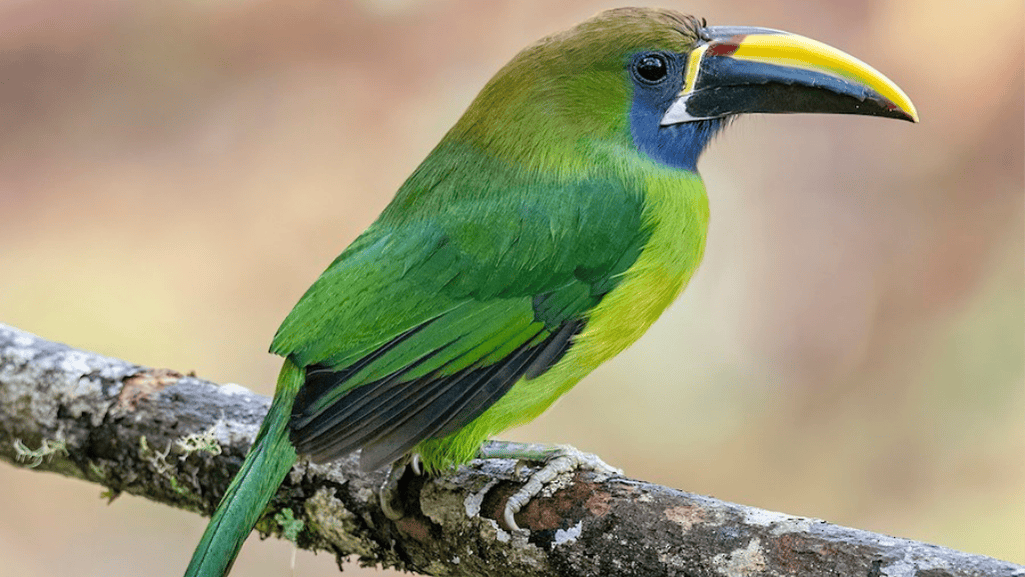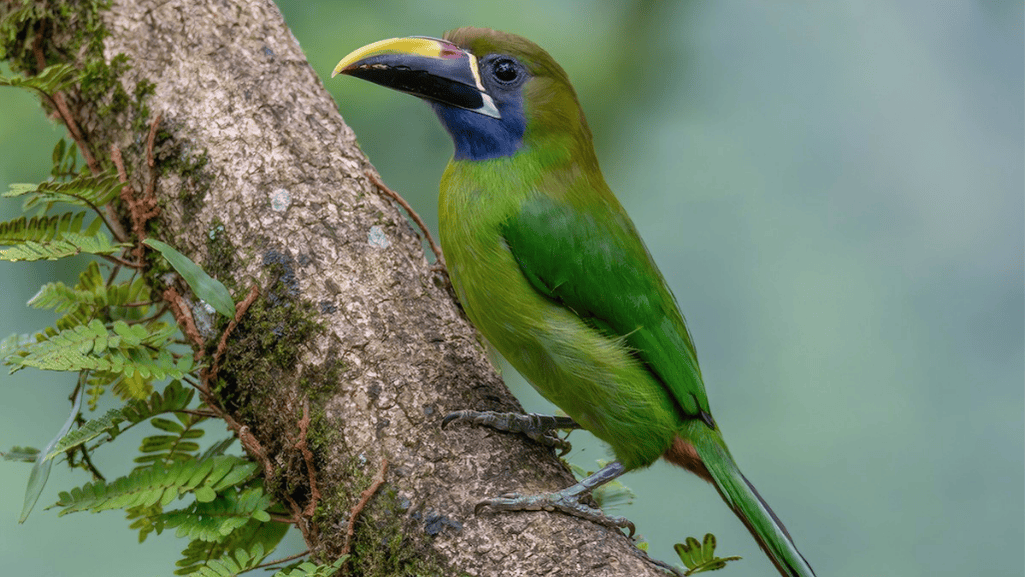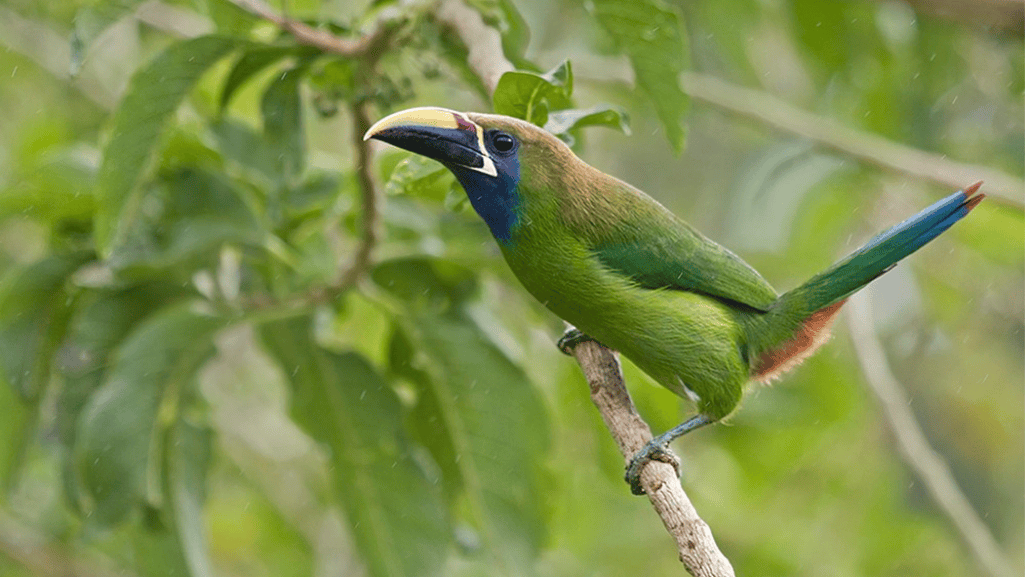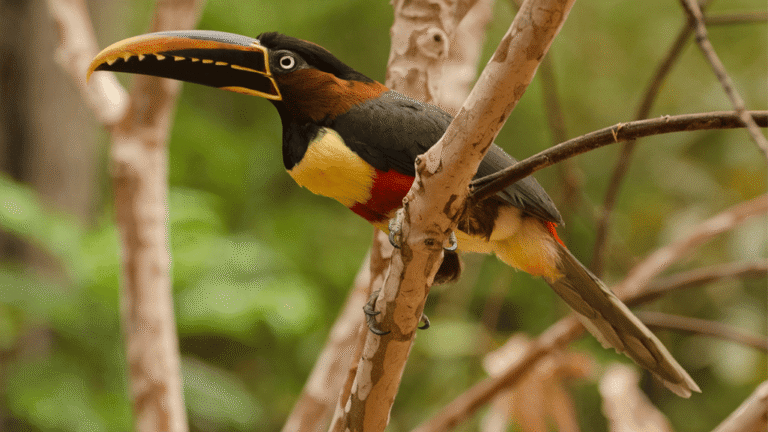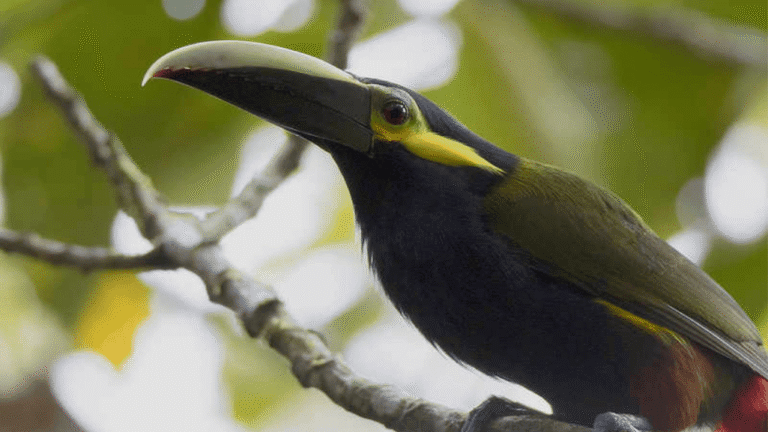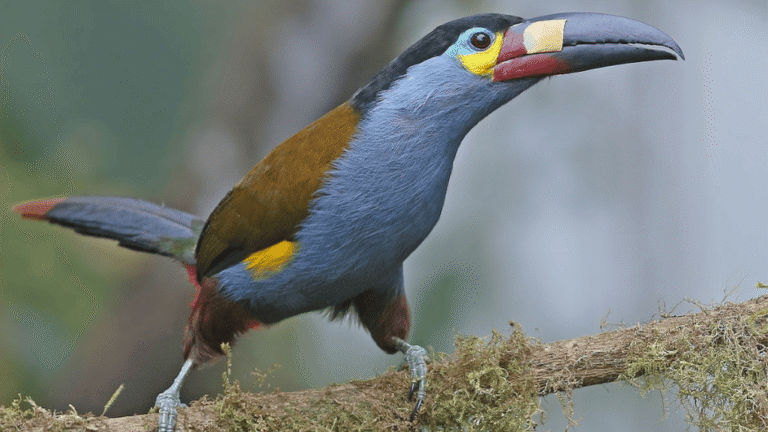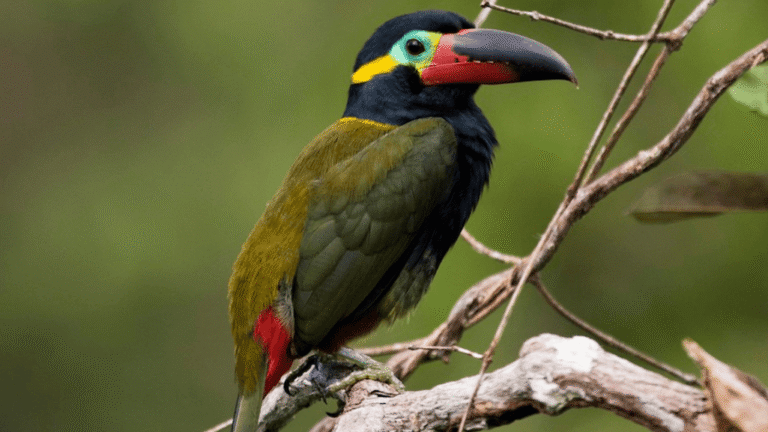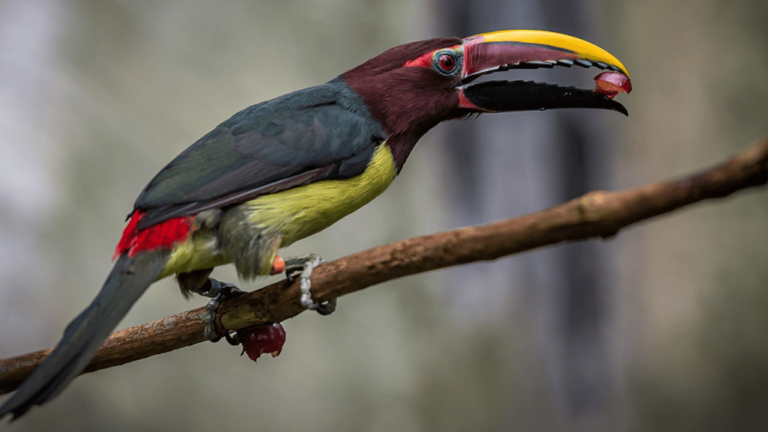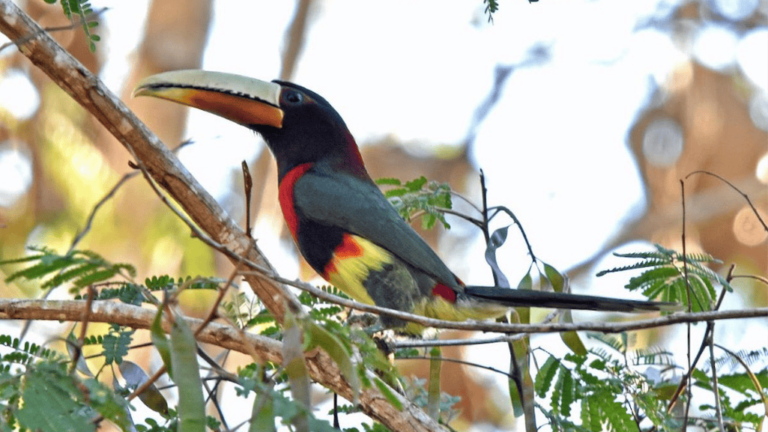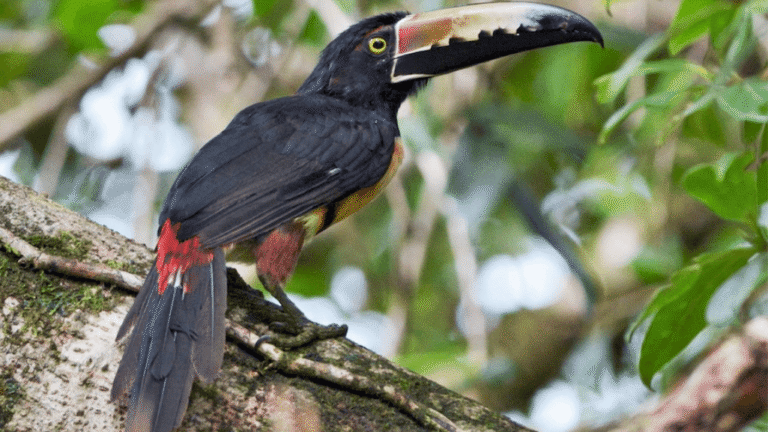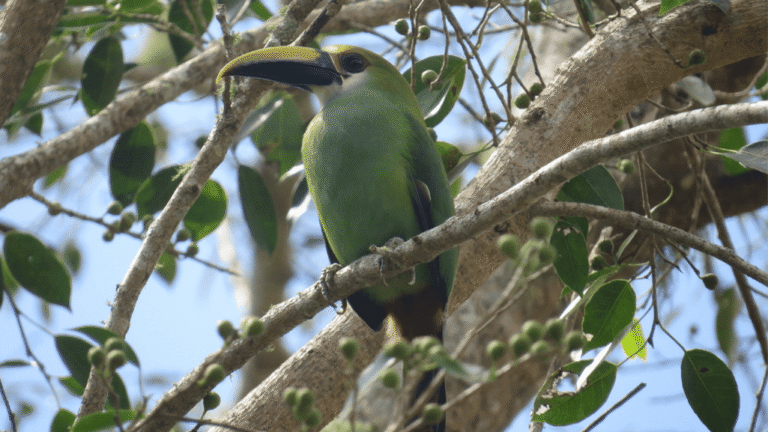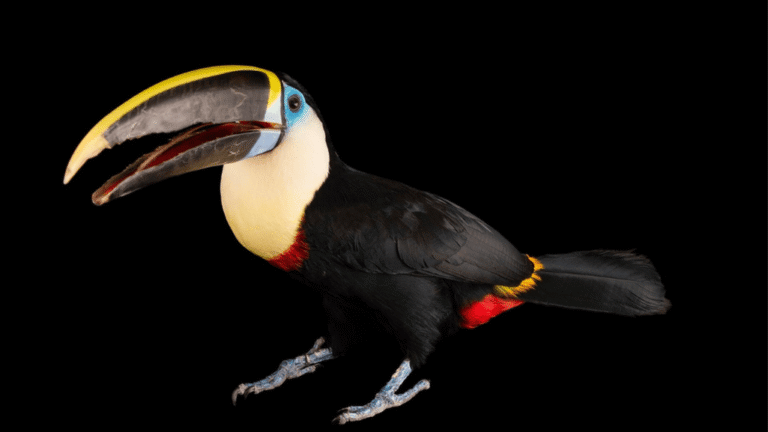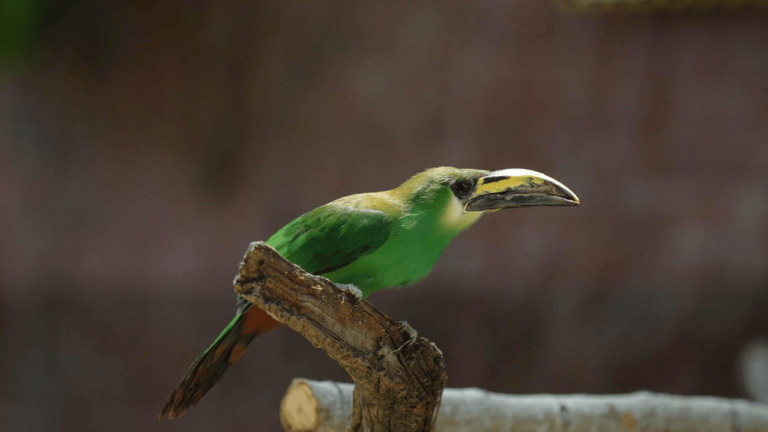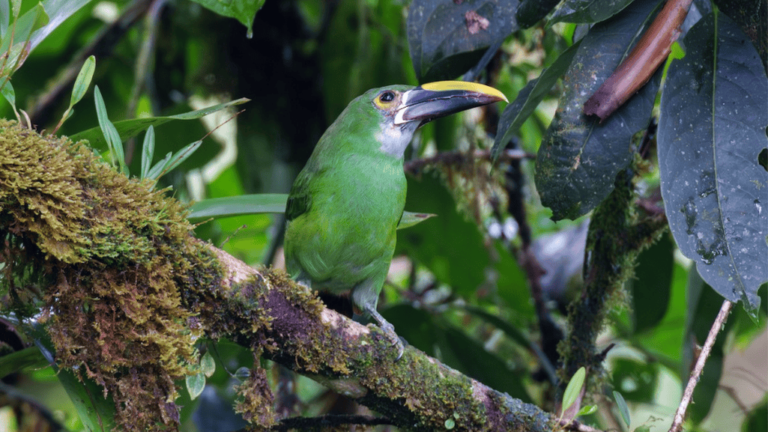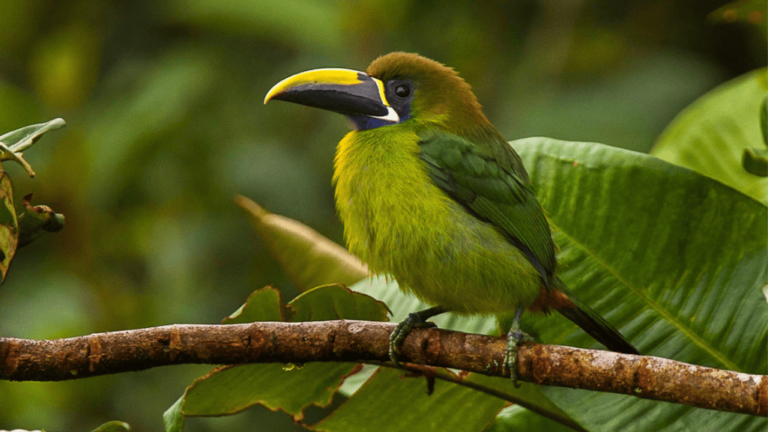The Emerald Toucanet, also known as Aulacorhynchus prasinus, is a stunning bird species found in Central and South America. With its vibrant green plumage and distinctive beak, this tropical bird is a favorite among birdwatchers and nature photographers. Let’s explore some interesting facts about the Emerald Toucanet and learn about its conservation status.
Key Takeaways:
- The Emerald Toucanet is a colorful bird species found in Central and South America.
- It has vibrant green feathers with highlights of whites, grays, and reddish browns.
- The Emerald Toucanet is monomorphic in color but dimorphic in size, with males weighing about 160g and females weighing about 149g.
- It inhabits the temperate and terrestrial regions, primarily in the rainforests at elevations ranging from 915 to 3050 meters.
- The species is abundant in Central and South America, particularly in Mexico, Costa Rica, and Panama.
Geographic Range and Habitat
The Emerald Toucanet is abundant in Central and South America, primarily along the eastern coast. It can be found in various parts of Central America, including Mexico, Costa Rica, and Panama. The species thrives in the lush habitats of the Neotropical region.
One of the favored habitats of the Emerald Toucanet is the high elevation cloud forests. These cloud forests are located in the mountainous regions of Mexico, Costa Rica, and Panama. The toucanets are well adapted to these environments and can be observed at elevations ranging from 915 to 3050 meters above sea level.
In recent years, there has been a remarkable development in the Emerald Toucanet’s range. They have expanded their habitat into lower elevation rainforests. This expansion indicates the species’ ability to adapt to different environments and thrive in diverse ecological settings.
The Emerald Toucanet’s native habitats in Central America offer perfect conditions for its survival. The temperate and terrestrial regions provide an excellent food supply and suitable nesting locations. These regions are known for their abundant insect populations and a wide variety of fruits, which form a significant portion of the toucanet’s diet.
Geographic Range and Key Habitats of the Emerald Toucanet
| Country | Primary Habitats |
|---|---|
| Mexico | High elevation cloud forests, lower elevation rainforests |
| Costa Rica | High elevation cloud forests, lower elevation rainforests |
| Panama | High elevation cloud forests, lower elevation rainforests |
Reproduction and Lifespan
The Emerald Toucanet exhibits fascinating reproductive behaviors and has a relatively long lifespan compared to other bird species.
During the mating season, which typically occurs from March to July, the Emerald Toucanet engages in intricate courtship rituals. Mating involves a unique behavior known as “bill fencing,” where the pair playfully spar with their beaks.
After mating, the female Emerald Toucanet lays three or four white eggs in a tree-hole nest. These nests are usually located between 2 to 30 meters above the ground, providing protection for the upcoming brood.
Both parents play an active role in the incubation process, taking turns to keep the eggs warm. The average incubation period for the Emerald Toucanet is around 16 days.
Once the eggs hatch, the chicks are altricial, meaning they require extensive care from their parents. The parents diligently feed, protect, and nurture their offspring until they reach the fledgling stage, which occurs at approximately 43 days old.
The Emerald Toucanet has an average lifespan of 10 to 11 years in the wild, allowing them to contribute to the ecosystem for an extended period. In captivity, they can live up to 14 years, providing researchers and enthusiasts ample time to study their behaviors and characteristics.
Behavior and Communication
![]()
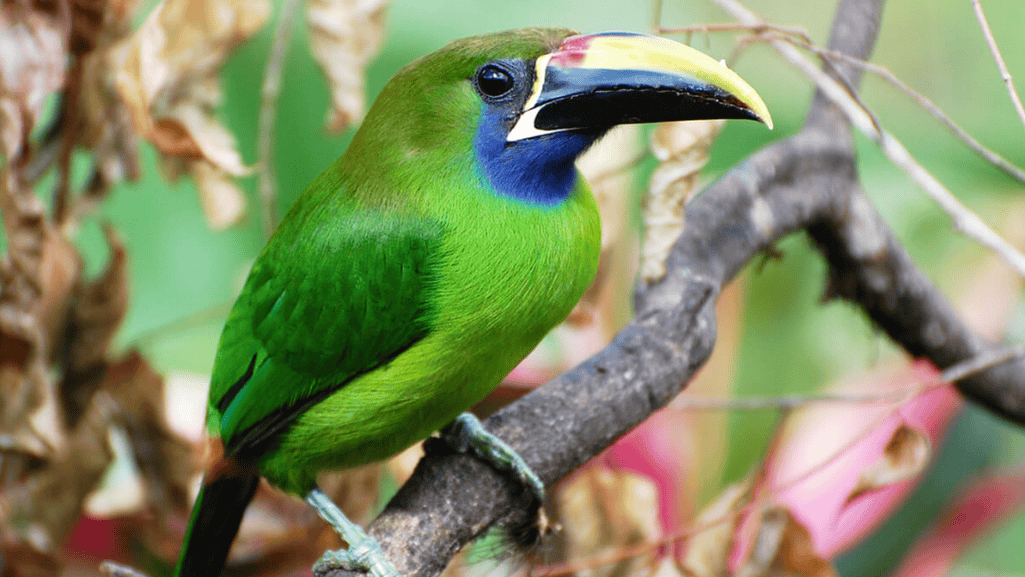 Emerald Toucanets are known for their active and social behavior. These colorful birds can be seen foraging for food in pairs or small flocks, covering large territories on a daily basis. They have a diverse diet, primarily consisting of insects and fruits. However, they may also consume lizards and the eggs or nestlings of other birds.
Emerald Toucanets are known for their active and social behavior. These colorful birds can be seen foraging for food in pairs or small flocks, covering large territories on a daily basis. They have a diverse diet, primarily consisting of insects and fruits. However, they may also consume lizards and the eggs or nestlings of other birds.
When it comes to roosting, Emerald Toucanets prefer to perch on tree branches rather than using nests. Nests are typically used only for incubating eggs and raising their brood. This behavior allows them to remain agile and mobile, ready to explore their surroundings and take advantage of food sources.
Communication among Emerald Toucanets is crucial for social bonding and maintaining group cohesion. These birds utilize various forms of communication, including visual, tactile, acoustic, and chemical signals. They have distinct vocalizations, which can be heard throughout the forest as they establish their presence and communicate with other toucanets.
The vocalizations of Emerald Toucanets are unique and easily recognizable. Their calls, such as the loud dry “rrip rrip rrip” and the distinctive graval graval graval sound, serve as a means of establishing territory, attracting mates, and coordinating group movements. These vocalizations are an essential part of their behavior and communication repertoire.
Behavior and Communication Summary:
- Emerald Toucanets forage for food in pairs or small flocks, covering large territories.
- Their diet consists of insects, fruits, lizards, and the eggs or nestlings of other birds.
- They roost in trees, perched on branches, and use nests primarily for incubation and raising their brood.
- Communication involves visual, tactile, acoustic, and chemical signals.
- Distinct vocalizations, such as the “rrip rrip rrip” and graval graval graval sound, are used for territory establishment and group coordination.
Ecological Role and Conservation Status
The Emerald Toucanet plays a crucial ecological role as a seed disperser in rainforests. This colorful bird aids in the dispersal of seeds for several tree species, contributing to the regeneration and diversity of the forest. When the toucanet consumes fruits, the seeds pass through its digestive tract undamaged. As the bird moves through the forest, it deposits the seeds in new locations, allowing for germination and growth in different areas.
This seed dispersal process is essential for the long-term survival of rainforest ecosystems. The Emerald Toucanet’s specialized digestive system ensures that the seeds have a higher germination rate compared to those that do not pass through the bird. By spreading seeds, the toucanet helps maintain the health and vitality of the rainforest by facilitating the establishment of new plant populations.
In terms of conservation status, the Emerald Toucanet is currently not listed as endangered on the IUCN Red List. However, habitat destruction poses a potential threat to its survival. Rainforest habitats, including the toucanet’s range, are under increasing pressure due to human activities such as deforestation, agriculture, and urbanization.
While the Emerald Toucanet has not been identified as an endangered species, the impact of habitat destruction, particularly related to the coffee market, may have adverse effects on its population in the future. Efforts to conserve and protect the rainforests where this species resides are crucial for its long-term survival and the preservation of its ecological role as a seed disperser.
Appearance and Physical Description
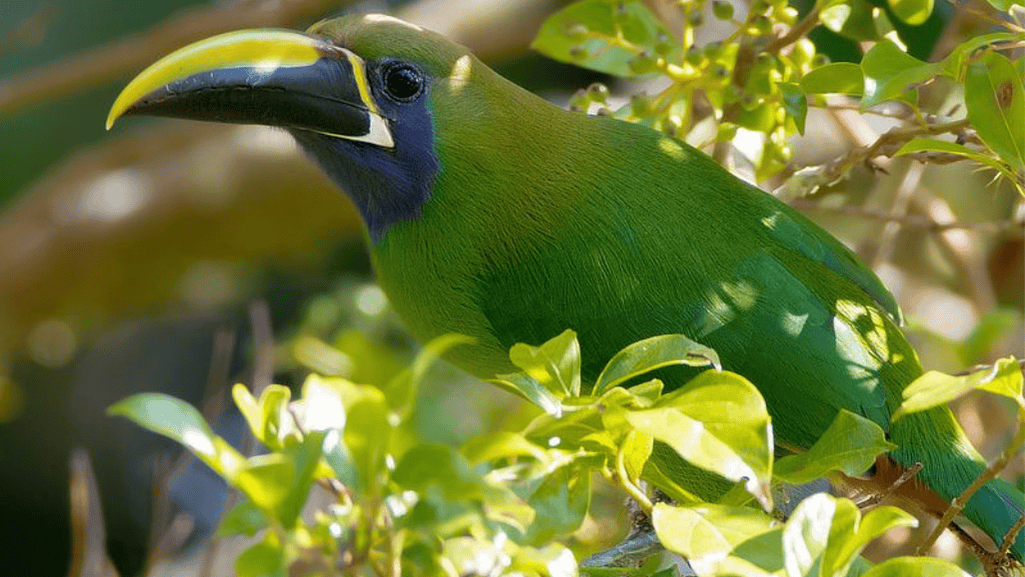 The Emerald Toucanet is a small-sized toucan species known for its vibrant plumage and distinctive beak. Measuring between 30 to 33 cm (11.8 to 13 inches) in length, it is the smallest of the toucans. Despite their small size, Emerald Toucanets make a bold impression with their striking physical characteristics.
The Emerald Toucanet is a small-sized toucan species known for its vibrant plumage and distinctive beak. Measuring between 30 to 33 cm (11.8 to 13 inches) in length, it is the smallest of the toucans. Despite their small size, Emerald Toucanets make a bold impression with their striking physical characteristics.
Both males and females exhibit monomorphic coloration, meaning they share the same color patterns. However, they differ in size, with males typically weighing around 160g (5.7 ounces) and females weighing around 149g (5.3 ounces).
The plumage of the Emerald Toucanet is dominantly green, blending seamlessly with the lush trees and foliage of their habitat. Their feathers are also adorned with highlights of white, gray, and reddish brown, adding depth and contrast to their appearance.
The most remarkable feature of the Emerald Toucanet is its bill. The beak is characterized by a yellow top and a black or dark red bottom, which can vary depending on the subspecies. This unique bill coloration not only adds to their visual appeal but also serves practical purposes in their natural environment.
Whether they are perched on the branches or darting through the trees, the Emerald Toucanet’s distinctive appearance and physical attributes make it a fascinating and eye-catching bird.
| Physical Characteristics | Description |
|---|---|
| Size | Ranges from 30 to 33 cm (11.8 to 13 inches) in length |
| Weight | Males weigh around 160g (5.7 ounces), while females weigh around 149g (5.3 ounces) |
| Coloration | Monomorphic plumage in vibrant shades of green with highlights of white, gray, and reddish brown |
| Bill Coloration | Distinctive yellow top and black or dark red bottom, varying by subspecies |
Distribution and Habitat Range
The Emerald Toucanet has a wide geographic range, primarily inhabiting the Neotropical region. Its distribution spans from central Mexico all the way to the northernmost parts of Venezuela in South America. While they are not heavily populated in the eastern-central regions of Mexico, they can be found in greater abundance in the southern mountainous areas, including Costa Rica and Panama.
The native habitats of the Emerald Toucanet are primarily located in Mexico, Costa Rica, and Panama, specifically in the higher elevation cloud forests. These temperate and terrestrial regions provide ideal conditions for the species to thrive. However, in recent years, they have also expanded their range into lower elevation rainforests, adapting to a broader range of habitats.
Overall, the Emerald Toucanet’s ability to inhabit a varied range of elevations and habitats highlights its adaptability and resilience in the face of changing environments.
Conclusion
The Emerald Toucanet, with its vibrant plumage and distinctive beak, is a captivating bird species that can be found in the tropical regions of Central and South America. This colorful toucan is a popular subject among birdwatchers and nature photographers, thanks to its eye-catching appearance and active behavior.
Currently, the Emerald Toucanet is not considered endangered. However, habitat destruction poses a significant threat to its population. To ensure the continued survival and well-being of this beautiful species, it is crucial to prioritize conservation efforts and protect their native habitats.
By conserving and preserving the diverse ecosystems inhabited by the Emerald Toucanet, we can contribute to the preservation of South American wildlife and the overall balance of these fragile ecosystems. Together, we can work towards a future where these magnificent birds continue to enchant us with their beauty and contribute to the biodiversity of our planet.
FAQ
What is the scientific name of the Emerald Toucanet?
The scientific name of the Emerald Toucanet is Aulacorhynchus prasinus.
Where is the Emerald Toucanet found?
The Emerald Toucanet is found in Central and South America, primarily in the rainforests of Mexico, Costa Rica, and Panama.
What does the Emerald Toucanet look like?
The Emerald Toucanet has vibrant green feathers with highlights of whites, grays, and reddish browns. Its beak is two-toned, with a yellow top and a black or dark red bottom.
How long do Emerald Toucanets live?
In the wild, the average lifespan of the Emerald Toucanet is 10 to 11 years, while in captivity, it can live up to 14 years.
What do Emerald Toucanets eat?
Emerald Toucanets primarily feed on insects and fruits, but they may also consume lizards and the eggs or nestlings of other birds.
What role do Emerald Toucanets play in the ecosystem?
Emerald Toucanets play a vital ecological role as seed dispersers for rainforest trees. Their digestive tract enhances seed germination rates.
Where are Emerald Toucanets commonly seen in the wild?
Emerald Toucanets are commonly seen in the higher elevation cloud forests of Mexico, Costa Rica, and Panama.
Is the Emerald Toucanet endangered?
While the Emerald Toucanet is not currently listed as endangered, habitat destruction poses a potential threat to its survival.


